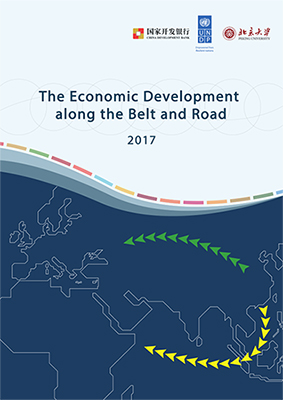Potential for cooperation under Belt and Road Initiative
Under the double circulation of global value framework, countries and regions that support the Belt and Road Initiative will have great potential for economic cooperation, according to an economic development report.

The Economic Development along the Belt and Road, jointly authored by China Development Bank, United Nations Development Programme China and Peking University, was launched on Monday in Beijing, providing a framework to access and analyze the initiative’s complexity and effects on national and regional development.
The report proposes the initiative as a double circulation of the global value chain, which can drive the economic growth, making involved countries’ industrial structures complementary to each other’s, and realizing the industrial synergy of the double circulation itself.
Taking China as an example, the double circulation is, said Wang Bo, vice-president of Peking University, that China exports intermediate goods to the developed countries and regions, and imports final goods from them; meanwhile, China imports intermediate goods from the developing world and exports final goods in return.
China’s rising labor costs push its labor-intensive industries to developing countries, such as some of those in Southeast Asia, as well as expands its exports of capital, technology and high value-added products, the report said.
“The initiative gives another opportunity for the Southeast Asia countries in term of their trades with China,” said Nicolas Rosellini, UN resident coordinator and UNDP resident representative in China, regarding the new progress Sino-Thai railway project has gained recently.
Sino-Thai Railway
Thailand confirmed last week that it had officially approved the environmental impact assessment of the first phase of the Sino-Thai railway project, which is expected to start construction later this month.
The railway is expected to connect China, Laos and Thailand as well as further facilitate the export of Thai agricultural products, promoting the double circulation between Thailand and other countries.
According to the report, the industrial upgrade of countries at higher value-added production stage (late-industrialization) will lead to the upgrade of those at the middle stage of industrialization (capital intensive) stage, which will lead to the corresponding upgrading of countries at the lower stage of industrialization, making the transfer of the value chain within countries involved in the Belt and Road Initiative easier, so that they can establish a production network and a cooperation model in the lower circulation.
The Chinese-proposed plan, comprising the overland Silk Road Economic Belt and the 21st-Century Maritime Silk Road, aims to build a trade, investment and infrastructure network connecting Asia with Europe and Africa along and beyond the ancient Silk Road trade routes.
The report suggests that countries involved in the plan,“despite their vast diversity in levels of economic development, can jointly benefit through socio-economic cooperation”, Rosellini said.